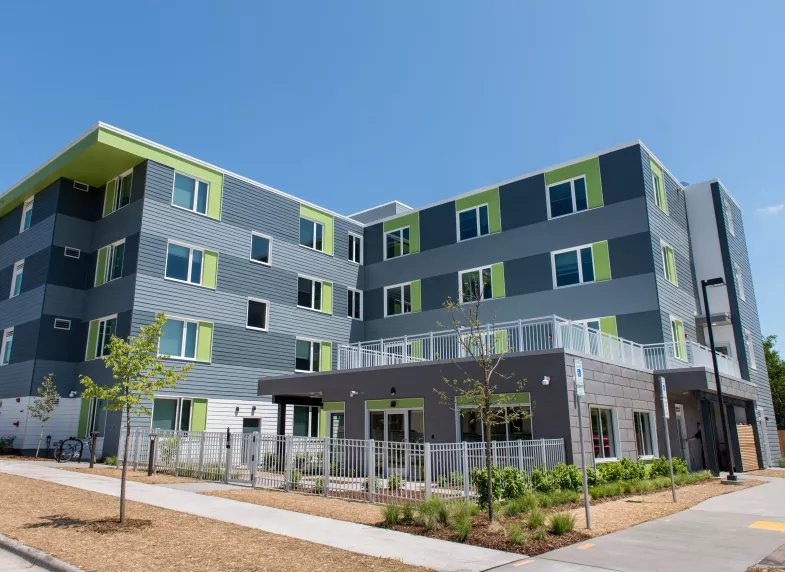
In this week’s blog, Phius Policy Specialist Isaac Elnecave provides a roundup of recent policy activity.
Recently, there has been a noticeable rise in Phius-related policy activity on both the Low-Income Housing Tax Credit (Qualified Allocation Plans) and energy codes:
- Incentives – Colorado
- Quality Allocation Plans (QAPs) – Wisconsin, Minnesota, Iowa and Texas
- Energy Codes – Massachusetts, New York, Michigan, Illinois and Chicago
The blog post this week will briefly cover the work happening on incentives and the QAP. Next week, we will cover the rapidly accelerating energy code activity occurring in several states.
Incentives
Colorado
Xcel Energy (a major utility in the area) will be rolling out its incentive program designed to help people who are rebuilding after losing their homes in the Marshall Fire in southeastern Boulder County. Xcel is looking to encourage people to rebuild homes to above the current code and will be providing an incentive of $37,500 for homeowners who rebuild to the Phius standard. For more information, check out the information sheet on the Xcel website.
In addition, Energysmart has created a new website that includes information on the incentive program as well as qualified builders. A builder who has received a Phius Certified Builder certification can be added to this list.
Qualified Allocation Plans
Background
The QAP is the document that state housing agencies use to evaluate which potential projects will receive tax credits for low-income projects. The QAP is a detailed document that specifies points for particular actions, often including a section that details the number of points that a project can receive for meeting sustainability/energy efficiency goals. Fifteen states currently include Phius as part of their QAPs, and a focus on Phius’ work is expanding this list of states.
Wisconsin
The Phius Alliance Wisconsin submitted comments to the Wisconsin Housing and Economic Development Authority (WHEDA) on their proposed update of their QAP. The comments requested that WHEDA give a 15-point option (in the energy efficiency section) for developers proposing to build to the Phius standard. Currently, the QAP gives points for building to the: Wisconsin Green Built Home Standard or Enterprise Green Communities Plus. The Alliance comments pointed out that a multifamily project built to the Phius standard would be significantly more energy efficient than the aforementioned standards.
Minnesota
Shortly after Wisconsin, the Phius Alliance Minnesota also submitted comments to their respective housing agency on its proposed update to the state QAP. Because the points in the energy efficiency section of the Minnesota QAP is structured differently than Wisconsin’s, the specific request differed. Nevertheless, the comments suggested changes that would include Phius as one of the ways to receive points as part of a proposed project. Several groups signed on this effort including: the Center for Energy and Environment, architecture firms including Precipitate, Alchemy Architecture, LHB and MSR Design, Frerichs Construction and material suppliers such as Owens Corning, Siga and Meteek Supply and 475 Supply.
Evidence from other states such as Massachusetts (and across New England), New York and Pennsylvania have indicated that enactment of these policies will lead to an increase in projects seeking Phius certification.
Iowa
The Iowa Finance Authority is in the process of updating its QAP. The IFA updates its QAP every two years. Currently, the state’s QAP does not include Phius. The agency requires projects to meet a baseline of Energy Star (although Enterprise Green Communities, LEED, or National Green Building Standard (Bronze Level) can be used instead. If a project wants additional points, Section 6.3.7 (Impact on the Environment) provides the opportunity. In this section, a project can receive 8 points by exceeding the efficiency of ASHRAE 90.1-2010 by 25% (the current edition of ASHRAE is 90.1-2019) or HERS Index below 62.
Phius will propose the addition of the Phius CORE standard (which is significantly more efficient than either of the two standards mentioned above) as part of this section. The IFA will have at least two public meetings (July 21 and August 9) and Phius will submit comments prior to the August 9 meeting.
Texas
The Texas Department of Housing and Community Affairs (TDHCA) is also updating its QAP. The department is running a two-step updating process. There will be a first round of comments due on August 3, which the department will use to update the proposed QAP and then take a second round of comments on its updated version. Currently, Phius is not included in the Texas QAP. A project can receive four points for building to: Enterprise Green Communities standard, LEED, NGBS or the 2018 International Green Construction Code (IGCC).
Similar to Iowa, one possibility would be for TDHCA to add Phius CORE/ZERO to the above group. The second set of comments will be on September 8. After this, the TDHCA will finalize the update.
Stay tuned for next week’s blog to hear all about the recent uptick in energy code activity in a number of states.
